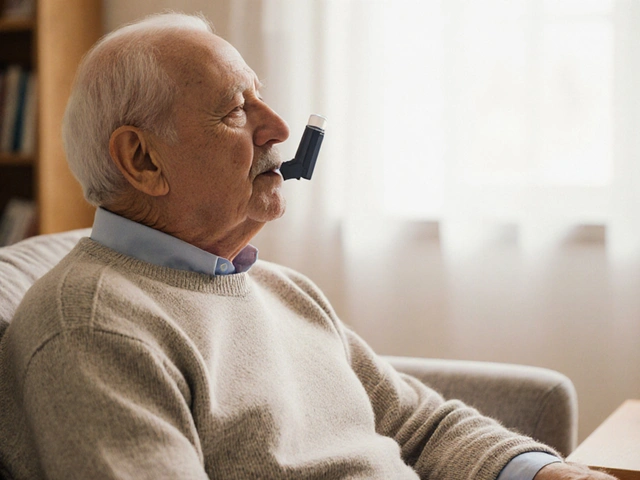Picture this: you're looking at a recent photo, and your hair seems just a little less full than last summer. Blame genetics? Sure, but that's just the half of it. The real game-changers fly under the radar—what you eat, how stressed you get, how well you sleep. In 2025, science is clear: these daily choices shape your hair’s destiny far more than magic shampoos or viral TikTok hacks. The coolest part? You have way more control than you think.
Nutrition: Fueling Your Follicles from the Inside
Let’s cut to the chase—your hair isn’t going to sprout like a weed unless you’re feeding it right. That means thinking beyond protein shakes or the odd salad. Hair is basically made of keratin, a tough protein, and it’s hungry for building blocks. Start with the basics: eggs, fish, nuts, Greek yogurt. These provide high-quality proteins and biotin, a B vitamin that your hair craves. Ever heard that iron deficiency wrecks your strands? It’s true. A lot of people don’t realize how quickly low iron snuffs out hair growth, especially in women under 40. Toss in spinach, beans, and lentils to cover your bases.
If you’re vegan or avoiding meat, don’t freak out—beans, chickpeas, and quinoa can step in. Zinc is another big player, helping to repair and keep hair growing. Get it from pumpkin seeds, cashews, and the humble oatmeal (yes, really). Omega-3 fatty acids from salmon or flaxseeds act like a shot of lube for your follicles—your scalp stays hydrated, the roots less inflamed. Even hydration matters; not enough water makes your hair dry and brittle, so aim for eight glasses a day as a baseline.
The bottom line: real, whole foods beat supplements most of the time. You’ll hear plenty in 2025 about people overdosing on hair vitamins without results. Studies show food-first nutrition provides co-factors—natural chemicals that help absorb and activate the vitamins you do get. By making your meals colorful and diverse, you’re stacking the deck for better hair. And don’t forget, crash dieting or skipping carbs can also torpedo hair health. If your weight-loss plan is making you moody and tired, your hair is feeling it too.
Finally, beware of so-called miracle diets. Keto, intermittent fasting, and ‘biohacking’ trends can easily leave you short on nutrients. Hair doesn’t appreciate wild swings or missing meals. If your scalp tingles or sheds more, it’s a red flag. Balance, not restriction, is your ally. Think of it as an insurance policy for your follicles—one that pays over years, not weeks.
Stress: The Follicle’s Worst Enemy
Maybe you think your job, family, or even doom-scrolling through news feeds is harmless. But hair doesn’t lie: stress is one of the fastest ways to zap growth and nudge follicles into “sleep mode.” And we’re not just talking about clumps coming out after a heartbreak. Chronic, simmering stress increases cortisol, which shrinks hair follicles over time. You won’t see immediate bald spots, but the damage sneaks up—thinning, more shedding, even changes in texture.
Here’s the kicker: your body can’t tell the difference between a real threat (like running from a bear) and work drama. So, it reacts the same way: it reroutes energy away from ‘non-essential’ stuff like hair production. The result? Dull, flat, breakage-prone strands. In 2025, wearable tech like smartwatches can clue you in by measuring heart rate variability—if it’s out of whack, stress may already be sinking its claws into your scalp. But you don’t need gadgets to spot the signs. If you’re losing more than 100 hairs a day for weeks, or you notice bald patches, stress could be in the driver’s seat.
What can you do? First, cut the guilt. Stress happens. Small daily habits make a huge dent: breathing exercises, short walks, even five minutes of meditation while your phone is charging. Social support is underrated—having someone to vent to cuts cortisol spikes by up to 20%. Hobbies like gardening, painting, or even adult coloring books have made big comebacks because they anchor you in the moment and give your mind a break. Get your hands dirty, and your hair might thank you.
Also, try to spot your stress triggers—work emails after hours, noisy environments, or too much caffeine (yeah, it’s a thing). You can’t dodge every bullet, but you can reduce your exposure. Even your phone can help: there are dozens of free mindfulness or breathing apps. Track your progress over weeks, not days. Hair responds to what you do consistently, not perfection. Bonus: stress reduction isn’t just for your hair. People report better skin, digestion, and sleep just by dialing down daily pressure.

Sleep: The Night Shift for Follicle Recovery
You’ve probably heard that muscles recover at night, but here’s the fun thing—so does your hair. When you skimp on sleep, everything slows, including cell turnover and hormone regulation. Follicles rely on melatonin, your sleep hormone, to nudge them through their growth cycles. Shift workers, new parents, or anyone hooked on late-night gaming can actually end up with less hair in just a few months. It sounds dramatic, but a real study in 2023 found that folks getting under six hours a night had almost 30% more hair-shedding days per month.
The sweet spot? Aim for seven to nine hours. Quality matters, not just clock time. Interrupted sleep (pets, phones, stress dreams) messes with deep sleep cycles—and that’s when follicle repair maxes out. Sleep hygiene isn’t just a buzzword: keep your bedroom dark, use blackout curtains, set a cool temperature, and stash devices at least 30 minutes before bed. Blue light from screens artificially cuts melatonin, making it harder for follicles to do their nightly tune-up.
If insomnia is your enemy, try winding down with routines—light stretching, a warm shower, or herbal teas (but skip overly stimulating herbs). Tracking your sleep with a journal (yes, pen and paper) can also reveal patterns you might miss. And be cautious with sleep aids; long-term reliance on pills won’t help hair if real rest is missing. Some people even swear by silk pillowcases—they reduce friction and help keep hair hydrated overnight. Not miracle-cures, but every edge counts.
If you wake up groggy, run through your day in zombie mode, or can’t remember your last “good night’s sleep,” take it as a call to action. Your hair will thank you—not overnight, but in the weeks and months ahead. By protecting sleep, you’re investing in follicle strength right when it needs it most.
Real-Life Tips and Modern Hacks for Everyday Hair Support
Everyone’s on the hunt for shortcuts, but great hair in 2025 still relies on showing up for the basics. Think of these steps as daily rituals, not chores. Start by planning your meals ahead—a little meal-prep on Sunday can set you up for a week of strong hair nourishment. If you’re not sure you’re getting enough diversity, snap a picture of your plate: if it’s mostly beige, you’re lacking. Challenge yourself to add a new veggie or nut every few days.
On the stress front, micro-breaks pay off. Set a silent alarm for “stretch time” every two hours. Do a handful of slow breaths (inhale, hold, exhale for five seconds) or get up and walk around for five minutes. If you work at a computer, make a playlist of songs that make you feel happy—music has real stress-busting science behind it, cutting stress hormone levels with just 10 minutes of listening.
Don’t overlook your scalp, either. Regular scalp massages aren’t just pleasant—they improve blood flow and nutrient delivery. You don’t need fancy oils; fingertips and circular motions for three minutes a day can work wonders. If dandruff or buildup is an issue, try a gentle exfoliating brush or a clarifying shampoo once a week.
And here’s something many don’t consider—hair need downtime too. Avoid super-tight hairstyles, harsh heat-styling, and over-washing. Alternate styles, go easy on dyes, and use leave-in conditioners with UV protection. In 2025, you’ll find plenty of creative products, but stick to ones free of heavy sulfates or mystery preservatives. Less is more, especially when your follicles are catching up after stress or poor sleep.
Wondering about supplements and medications? If you’re transitioning off meds like finasteride, it’s smart to look up ways to support hair growth naturally to keep gains going while you dial in your routine.
Community matters, too. There’s strength in swapping tips with friends, following real stories on social platforms, and embracing setbacks as part of the journey rather than failures. Celebrate small wins—fewer split ends, smoother feel, or simply less hair in the drain. Each one is proof you’re steering the ship, not adrift in the wind.

Science-Backed Research and What’s New in 2025
There’s a new wave of research in 2025 putting lifestyle under the microscope. The old advice—“just don’t stress out”—was way too simplistic. Scientists are tracking how specific nutrients, especially vitamin D and amino acids, turn on growth genes at the follicle’s root. If you get less sun or live at northern latitudes, taking walks outside midday could give your hair an extra lift through better vitamin D production. A recent clinical trial showed people adding daily sunlight and oily fish to their routines reduced shedding by nearly a fifth over six months.
Sleep tech is also evolving—some smart pillows now track head movements and sound levels to help tweak your room environment until you get the most restorative rest. Apps have gotten smarter at promoting wind-down periods, sending reminders when to dim lights and power down devices. The data doesn’t lie—people who follow these cues see more consistent hair density and faster regrowth after sickness or medicine changes.
The conversation about stress is getting more targeted, too. Employers and schools are experimenting with “wellness breaks” built into schedules because they’ve found that regular, structured downtime lowers not just job burnout, but also visible hair loss in high-pressure environments. If your boss offers these, take them—science says it’s worth it.
Most game-changing discovery? Genetics aren’t a death sentence. New twin studies find that lifestyle can override up to 40% of genetic hair loss risk. Sure, you might not reverse hereditary thinning, but you can slow it, soften its impact, and keep more hair longer than anyone thought possible a generation ago.
If you’re ready to make your lifestyle habits work for you, start small. Better meals, smarter stress management, and quality sleep are the real triple threat. It’s not about wild promises—it’s about making the ordinary stuff work in your favor, day after day. Stronger, fuller hair is the bonus prize.









Shanmughasundhar Sengeni May 24, 2025
Wow, another “miracle diet” miracle, because that never works.
ankush kumar May 25, 2025
Alright, let me break this down for everyone – first off, the idea that you can just pop a pill and wake up with Rapunzel‑level hair is *pretty* far‑fetched.
We all know the body is a complex ecosystem, and nutrients don’t just teleport to your scalp the moment you swallow a capsule.
When you actually sit down and eat a balanced meal – think eggs, nuts, fish, leafy greens – you’re giving your keratin the raw materials it needs to rebuild.
Biotin is great, but without iron your hair will still feel like it’s in a perpetual state of famine, especially for women under forty.
If you’re veging out on a plant‑only diet, make sure you’re loading up on legumes, quinoa, and maybe a fortified B‑12 supplement to avoid the classic deficiencies.
Omega‑3s from salmon or flaxseeds act like a natural conditioner from the inside, keeping the follicle membrane supple and reducing inflammation.
Hydration is another underrated factor – eight glasses a day is a baseline, but if you’re exercising a lot, bump that up; dehydration makes the shaft brittle and prone to breakage.
Crash diets? Forget about it. The hormonal rollercoaster they trigger can push you into telogen effluvium faster than you can say “keto.”
And don’t even get me started on intermittent fasting while trying to bulk up your hair; the timing of nutrient intake matters for absorption.
Stress is another silent hair‑killer; cortisol spikes can shrink follicles, so consistent relaxation techniques are non‑negotiable.
Sleep, as the article mentions, is the night‑time repair crew for your scalp – aim for at least seven hours of uninterrupted REM.
Technology like smart pillows can help fine‑tune that, but the fundamentals remain the same: darkness, cool temps, no screens.
Scalp massage is a simple hack – three minutes a day with just your fingertips can boost blood flow without the need for fancy oils.
Lastly, avoid harsh chemicals – sulfates, parabens, and over‑processing are the villains you can control.
In short, think of your hair like a house: you need solid foundations (nutrition), stable weather (stress management), and regular maintenance (sleep and care).
Stick to this routine, and you’ll see measurable improvements over months, not days.
Cameron White May 25, 2025
People don’t realize that the big supplement companies are in cahoots with the media to push you to buy endless pills. They want you focused on quick fixes while they hide the simple truth: balanced meals work way better.
Amélie Robillard May 26, 2025
Oh great, another post telling us to drink eight glasses of water – because we all have a personal waterfall in the kitchen, right? 🙄💦 Anyway, if you actually follow the basics, you’ll probably notice a difference, so cheers to that.
Fae Wings May 26, 2025
Totally feel you! 😅 The stress‑relief hacks are legit – a five‑minute breathing break totally changed my hair’s mood today.
Anupama Pasricha May 26, 2025
From a nutrigenomics perspective, the synergy between zinc, iron, and biotin creates a co‑factor cascade that optimizes keratin synthesis. Ensuring you meet the RDA for these micronutrients can modulate the expression of hair‑growth genes, especially in people with a predisposition to telogen shift.
Bryce Charette May 27, 2025
Quick tip: watch your “hair‑day” pronouns – it’s “your hair,” not “you hair.” Small grammar wins make the post smoother.
Christina Burkhardt May 27, 2025
Great summary! If you’re looking for a practical starter, try a simple meal‑prep plan: scrambled eggs with spinach on Monday, salmon‑quinoa bowl on Wednesday, and a lentil soup on Friday. Pair each with a 10‑minute evening stretch to lower cortisol.
liam martin May 27, 2025
Isn’t it poetic how our hair mirrors the chaos of existence? Every strand a story, every shed a sigh.
Ria Ayu May 28, 2025
When we consider hair as a living indicator, it becomes a subtle meditation on how lifestyle choices echo through our biology.
maya steele May 28, 2025
In clinical terms, the interplay between melatonin secretion and follicular cycling underscores the importance of sleep hygiene. Implementing a consistent bedtime routine can significantly reduce shedding episodes.
Sharon Lax May 28, 2025
While the article covers basics well, it glosses over the fact that many of these recommendations lack high‑quality randomized trials. Without solid evidence, it’s hard to endorse them as definitive solutions.
paulette pyla May 28, 2025
Honestly, if you’re still buying “hair‑growth” pills made in some shady lab, you’re just funding a scam that would make even the most gullible politician blush.
Benjamin Cook May 29, 2025
Wow!!! This is SO helpful!!! Can't wait to try the scalp massage thing!!! Thanks for the tips!!!
karthik rao May 29, 2025
From a grammatical standpoint, the phrase “your hair doesn’t appreciate wild swings or missing meals” should be revised to “your hair does not appreciate wild swings or missed meals” for clarity and formality. Additionally, preserving parallel structure enhances readability.
Breanne McNitt May 29, 2025
Love the community angle! I think we could all share our favorite low‑stress recipes in the comments – let’s build a repo of hair‑friendly meals.
Ashika Amirta varsha Balasubramanian May 29, 2025
Reflecting on the cultural nuances of diet, it’s clear that traditional Indian spices like fenugreek and curry leaves have been used for centuries to promote scalp health – modern science is finally catching up.
Jacqueline von Zwehl May 29, 2025
Just a note: “to ensure you’re getting enough diversity” would read better as “to ensure you get enough diversity.” Small tweaks make a big difference.